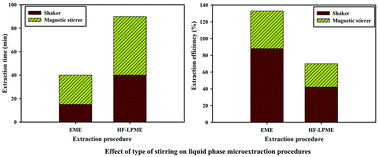Effect of type of stirring on hollow fiber liquid phase microextraction and electromembrane extraction of basic drugs: speed up extraction time and enhancement of extraction efficiency
Abstract
In microextraction procedures, the stirring of the donor solution is crucial to speed up the extraction. Two different stirring modes can be used in microextraction procedures: magnetic stirring and shaking. In this study, both hollow fiber liquid phase microextraction (HF-LPME) and electromembrane extraction (EME) procedures were considered to extract some model basic compounds under the two different mentioned stirring modes. At optimized shaking-assisted EME conditions (extraction time, 15 min; pH of acceptor solution, 2; pH of donor solution, 5; and shaking rate, 3000 rpm), 72–88% recoveries were achieved. The relative standard deviations of the analysis were found to be in the range of 6.7–13.5% (n = 5) and limits of detection ranged from 0.3 to 1.5 ng mL−1. In both of the mentioned extraction procedures, the use of a shaker was found to be associated with higher extraction rate and efficiency. The use of a shaker at the same rpm increased the area under the peak by a factor of 1.5, as compared to that of the magnetic stirrer. Using the shaker, 40% and 20% reductions were observed in optimal extraction times for EME and HF-LPME, respectively. Therefore, compared to HF-LPME method, EME was found to have larger contributions from the type of stirring. Also, results showed that the type of stirring was more important as the sample solution volume was increased (2–9 mL) while extraction efficiency was independent of stirring type for a low volume of sample solution (2 mL).


 Please wait while we load your content...
Please wait while we load your content...